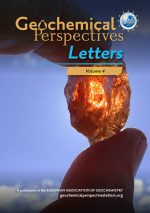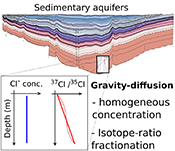 | The gravitas of gravitational isotope fractionation revealed in an isolated aquifer Abstract: Despite the ubiquitous effects of gravitation on Earth, its potential influence on relative distribution of isotopic substances has remained elusive – and so far only identified in confined gaseous systems (Craig et al., 1988, 1998). Yet, in a motionless and chemically homogeneous water column, dissolved isotopic substances must be distributed according to their masses. Here we report the first resolvable isotopic variations resulting from gravitational effects on solutes, identified on dissolved chloride (Cl-) and bromide (Br-) in a sedimentary aquifer from the Illinois Basin (USA). We show that the correlations between depth and both 37Cl/35Cl and 81Br/79Br – varying by 1.1 ‰ and 1.6 ‰ respectively – reflect the evolution toward a gravity-diffusion equilibrium of porewater in the sediment column. This observation reveals that these deep groundwaters have been mostly stagnant for at least 20 Myr, possibly up to 300 Myr. As chloride and bromide are often conservative in groundwater systems, we highlight their essential role in unravelling the hydrodynamics and residence times of isolated aquifers. Furthermore, this study reveals gravitational fractionation as a viable process, potentially affecting other isotopic systems in various geological settings. |
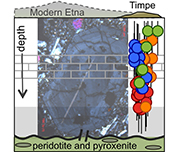 | Magma dynamics of ancient Mt. Etna inferred from clinopyroxene isotopic and trace element systematics Abstract: Dynamic magmatic processes driving volcanic eruptions, including melting, fractionation, and assimilation, provide critical insights into plumbing systems supporting long-lived magmatism. Here we describe an approach combining in situ elemental analyses in clinopyroxene phenocrysts, integrated thermobarometry models, and bulk crystalline Hf, Nd, and Pb isotopic studies to reconstruct a key period of ancient eruptions of Mount Etna (Sicily), Europe’s largest, most active volcano. Trace element signatures recorded in clinopyroxene from 220 to 100 ka are consistent with derivation from a heterogeneous mantle of hydrated peridotite and ~10 % pyroxenite, also consistent with sources feeding recent Etna eruptions. Isotopic data from Mount Etna alkaline lava clinopyroxene, crystallised between 0.5 and 0.2 GPa, insignificantly vary from whole rock values, ruling out substantive assimilation of material during magma ascent from the onset of clinopyroxene fractionation through the mid-crust, storage, and eruption. Together, our results suggest that varying contributions of well-mixed hydrated peridotite and pyroxenite melts have been consistent features of magma assembly beneath Mt. Etna since the development of ancient alkaline centres. |
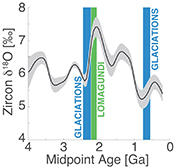 | Running out of gas: Zircon 18O-Hf-U/Pb evidence for Snowball Earth preconditioned by low degassing Abstract: The general long-term stability of Earth’s climate over geologic time was punctuated by dramatic excursions. Between ca. 2.5 and 0.5 billion years ago (Ga), these events included the globally extensive glaciations known as Snowball Earths, when ice extended to tropical latitudes. Such anomalous periods of time provide unique opportunities for understanding the mechanisms regulating planetary climate and habitability. However, the causes of these events remain enigmatic, in part because there is little information about fluxes in the global carbon cycle in deep time. We propose that the oxygen stable isotope composition in zircons (δ18Ozircon) contains information about past weathering conditions on the continents, imparted during the time between separation of parent material from the mantle (reflected in the Hf model age) and zircon crystallisation (the U/Pb age). A new compilation of coupled 18O-Hf-U/Pb isotopic data shows that the mean δ18Ozircon value varied particularly between 2.5 Ga and 0.5 Ga. The maximum in the δ18Ozircon record, which we interpret as a time of intense weathering, is associated with the Lomagundi Event (~2.22–2.07 Ga), a dramatic carbon isotope excursion thought to reflect enhanced organic carbon burial facilitated by the release of phosphorous during rock weathering. The onset of the Neoproterozoic Snowball Earth events coincides with the minimum in δ18Ozircon, suggesting low silicate weathering rates at the time. This evidence suggests that long-term decreases in the rate of CO2 release to the atmosphere from solid Earth degassing may have preconditioned the global climate system for intense glaciations. |
 | Stable strontium isotopic heterogeneity in the solar system from double-spike data Abstract: Strontium isotopic anomalies in meteorites are important in assessing nucleosynthetic sources to, and measuring the timing of, early solar system processes. However, conventional use of a constant 88Sr/86Sr value in correcting for instrumental mass fractionation during analysis renders measurements ambiguous and removes information on mass-dependent fractionation variations. From double-spike techniques we obtain data for the four stable strontium isotopes free of this ambiguity, and report measurements from a range of meteoritic, lunar and terrestrial materials. The Earth, Moon, basaltic eucrites and feldspars from angrites (differentiated samples) follow a single mass-dependent fractionation line and have a common nucleosynthetic origin in terms of their strontium isotopes. In contrast, bulk rock CI, CV3, CM and CO chondrite samples serve to define another mass-dependent fractionation line, displaced by 94 ± 28 ppm to heavier 84Sr/86Sr and/or 88Sr/86Sr ratios than that for the differentiated samples. Our Sr-isotopic data are consistent with a primary contrast in early solar system composition between an outer zone of primitive, mostly undifferentiated, materials and an inner zone of (almost entirely) differentiated materials that accumulated to form the terrestrial planets. |
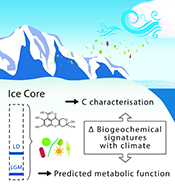 | Climate driven carbon and microbial signatures through the last ice age Abstract: Ice cores preserve diverse materials as millennial-scale proxies for Earth’s history. While major ions and elemental analyses are commonly investigated in palaeoclimate reconstructions, the integration of biological measurements is rapidly developing. Although the limited number of data herein impose constraints on broader generalisations, we show that microbial assemblages and organic matter (OM) composition from Byrd Station and West Antarctic Ice Sheet Divide ice cores may serve as palaeoecological markers from the Last Glacial Maximum (LGM; section ~20.5 ka BP) and last deglaciation periods (LD; section ~14.5 ka BP), reflecting environmental changes. Fluorescent analyses determined OM from both cores to have similar amino acid-like signatures; however, more comprehensive molecular characterisation showed only 12 % overlap in molecular formulae, with Byrd OM being more chemically labile. Microbial diversity in both cores was low, and together with predicted metabolic capabilities, differed significantly between communities. Variation in OM composition and microbial diversity reflects changes in environmental sources and deposition patterns onto the Antarctic Ice Sheet during distinct climate periods, with OM composition potentially shaping microbial communities post-deposition. Combining detailed microbial and OM composition analyses created a unique window into the past, providing a way to characterise carbon composition and potential metabolic processes as a function of environmental change. |
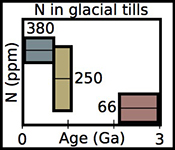 | A secular increase in continental crust nitrogen during the Precambrian Abstract: Recent work indicates the presence of substantial geologic nitrogen reservoirs in the mantle and continental crust. Importantly, this geologic nitrogen has exchanged between the atmosphere and the solid Earth over time. Changes in atmospheric nitrogen (i.e. atmospheric mass) have direct effects on climate and biological productivity. It is difficult to constrain, however, the evolution of the major nitrogen reservoirs through time. Here we show a secular increase in continental crust nitrogen through Earth history recorded in glacial tills (2.9 Ga to modern), which act as a proxy for average upper continental crust composition. Archean and earliest Palaeoproterozoic tills contain 66 ± 100 ppm nitrogen, whereas Neoproterozoic and Phanerozoic tills contain 290 ± 165 ppm nitrogen, whilst the isotopic composition has remained constant at ∼4 ‰. Nitrogen has accumulated in the continental crust through time, likely sequestered from the atmosphere via biological fixation. Our findings support dynamic, non-steady state behaviour of nitrogen through time, and are consistent with net transfer of atmospheric N to geologic reservoirs over time. |
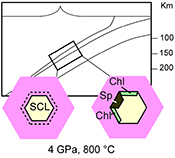 | Primary spinel + chlorite inclusions in mantle garnet formed at ultrahigh-pressure Abstract: Multiphase inclusions represent microenvironments where the interaction between fluid and host mineral is preserved during the rock geological path. Under its peculiar chemical-physical constraints, the entrapped solute-rich fluid might follow a crystallisation mechanism which is not predictable through simple equilibrium arguments. In this letter, by the modelling of solid-solution equilibrium and the application of principles of mass conservation, we demonstrate that cavities in mantle garnet filled with slab-derived fluids can re-equilibrate to a pyrope + spinel + chlorite assemblage at the same high P-T of their formation. The basis of this occurrence is a dissolution-reprecipitation mechanism, triggered by a dilute, non-equilibrated slab fluid. |
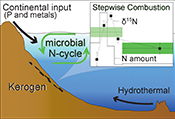 | Microbial nitrogen cycle enhanced by continental input recorded in the Gunflint Formation Abstract: Nitrogen isotope compositions (δ15N values) of kerogen in the sedimentary rocks from the 1878 Ma Gunflint Formation were analysed to understand the relationships among microbial activities, ocean chemistry, and tectonic evolution in the Animikie Basin. In the present study, the stepwise combustion analysis, performed on 13 kerogen samples, indicates that the δ15N values of kerogen can be sub-divided into two fractions with discrete values depending on the combustion temperatures: a lower-temperature fraction (from 500 to 575 ˚C), and a higher-temperature fraction (higher than 575 ˚C). A positive correlation was observed between the δ15N values of the lower-temperature fractions and Pr/Sm ratios, which represent contributions from the continental input. In contrast, no correlation was observed between the δ15N values of the higher-temperature fractions and the Pr/Sm ratios. This relationship between the δ15N values and the continental inputs is explained by the isotopic fractionation effects of the biological nitrogen cycle associated with the enhanced microbial activity, triggered by the active tectonic settings in the Animikie basin. |
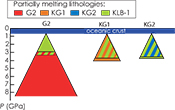 | No direct contribution of recycled crust in Icelandic basalts Abstract: Using Melt-PX to model the decompression melting of a heterogeneous mantle, I investigated the role of major-element composition of the lithologies present in the source on magmatic productivity, and trace element and isotopic melt compositions, independently of the bulk mantle composition. My calculations demonstrate that the volume of magma produced is not significantly affected by the nature of the lithological heterogeneity, but depends on the bulk mantle composition. However, an isochemical bulk mantle can produce contrasting trace element and isotopic melt compositions depending on the major-element compositions of the lithologies present in the source. Results show that the observed crust thickness of the Icelandic rift zones is consistent with about 10 % of recycled crust in the source, but also demonstrate there is no need to involve the contribution of melts derived from a recycled basalt component to explain the compositional variability of the Icelandic basalts in rift zones, and rather advance the contribution of olivine-bearing hybrid lithologies formed by solid-state reactions between the recycled crust and the peridotite. |
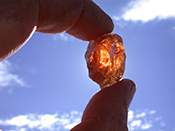 | Tracking continental-scale modification of the Earth’s mantle using zircon megacrysts Abstract: Metasomatism, the chemical alteration of rocks by a variety of melts and fluids, has formed a key concept in studies of the Earth’s mantle for decades. Metasomatic effects are often inferred to be far-reaching and yet the evidence for their occurrence is usually based upon individual hand specimens or suites of rocks that display considerable heterogeneity. In rare cases, however, we are offered insights into larger-scale chemical modifications that occur in the mantle. Here we utilise the Lu–Hf systematics of zircon megacrysts erupted in kimberlite magmas to discern two temporally and compositionally discrete metasomatic events in the mantle beneath southern Africa, each having an influence extending over an area exceeding one million km2. These data provide unambiguous evidence for metasomatic processes operating at continental scales and seemingly unperturbed by the age and composition of the local lithospheric mantle. The most recent of these events may be associated with the major Jurassic-Karoo magmatism in southern Africa. |
<< Previous issueNext issue >>





